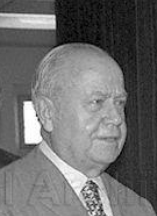Hans Günther Sohl
( businessman) | ||||||||||||
|---|---|---|---|---|---|---|---|---|---|---|---|---|
 | ||||||||||||
| Born | 2 May 1906 Danzig, Germany | |||||||||||
| Died | 13 November 1989 (Age 83) Düsseldorf, Germany | |||||||||||
| Nationality | German | |||||||||||
| Member of | Atlantik-Brücke | |||||||||||
| Party | NSDAP | |||||||||||
Head of Europe's biggest steel maker. Attended two Bilderbergs in the 1950s after being "denazified".
| ||||||||||||
Dr. Hans Günther Sohl was a German business executive.[1] As a Wehrwirtschaftsführer and board member of the conglomerate Vereinigte Stahlwerke, he was involved in the use of forced labor during World War 2. After a "denazification", he as Chairman of the Executive Board of the successor group Thyssen AG from 1953 to 1973 made the company the largest steel group in Europe. He attended the September 1955 and 1956 Bilderberg meetings. From 1972 to 1976 he was President of the Federation of German Industries.
Background
He was born in Danzig, the son of the lawyer and ministerial official Georg Sohl, and had two brothers. In 1917 the family moved to Berlin, where Hans-Günther Sohl passed the Abitur in 1924.
Education
On April 1, 1924, he began training as a mining assessor at the Prussian Mining Authority in Breslau. He successfully completed his studies in 1932.
Career
Sohl started his first job as an industrial engineer at the Mathias Stinnes colliery in Essen in 1932. In 1933 he joined the Nazi Party.[2] In the same year he moved to the Raw Materials Department of Friedrich Krupp AG, whose management he took over in 1935. From 1 October 1941 he replaced Hermann Wenzel as chairman of the industrial conglomerate Vereinigte Stahlwerke (United Steel Works). Due to the resignation of Ernst Poensgen, he was appointed Deputy Chairman of the Board of Vereinigte Stahlwerke under Walter Rohland in November 1943. Already in 1942, Sohl was appointed Wehrwirtschaftsführer of the Reichsvereinigung Eisen.[2]
As board member of the Vereinigten Stahlwerke and business director of Reichsvereinigung Eisen (Reich Federation of Iron Producers), he was one of the main perpetrators of forced labour and natural resource robbery in the occupied territories.[3]
With the end of the war, Sohl was arrested based on the Central Registry of War Crimes and Security Suspects (CROWCASS) on December 1, 1945, initially taken to an interim camp in Iserlohn and interned at the interrogation center Bad Nenndorf from December 4, 1945, followed by other camps. He was released in May 1947.[2]
Brought back to the Board of Vereinigte Stahlwerke at the turn of the year 1947/48, Sohl, together with Siegfried Seelig and Hermann Wenzel, was responsible for the unbundling of the conglomerate structure and dismantling of Vereinigte Stahlwerke and participated in the redesign of German heavy industry. In 1953 he became Chairman of the Executive Board of Thyssen AG (one of the successor companies of Vereinigte Stahlwerke). With the takeover of the majority of the Rheinstahl Group in 1973 - shortly before Sohl's age–related replacement by his successor Dieter Spethmann – Thyssen became the largest steel group in Europe and the second largest in the world.
Sohl was chairman of the Steel Industry Association from 1956 to 1969 and president of the Federation of German Industries (BDI) from 1972 to 1976.
His villa he built in 1960 had a nuclear bunker.[4]
Events Participated in
| Event | Start | End | Location(s) | Description |
|---|---|---|---|---|
| Bilderberg/1955 September | 23 September 1955 | 25 September 1955 | Germany Bavaria Garmisch-Partenkirchen | The third Bilderberg, in West Germany. The subject of a report by Der Spiegel which inspired a heavy blackout of subsequent meetings. |
| Bilderberg/1956 | 11 May 1956 | 13 May 1956 | Denmark Fredensborg | The 4th Bilderberg meeting, with 147 guests, in contrast to the generally smaller meetings of the 1950s. Has two Bilderberg meetings in the years before and after |
References
- ↑ http://www.spiegel.de/spiegel/print/d-45144182.html
- ↑ Jump up to: a b c Ernst Klee: Das Personenlexikon zum Dritten Reich. Wer war was vor und nach 1945, Frankfurt am Main 2005, S. 586.
- ↑ https://www.wsws.org/en/articles/2015/09/14/naz3-s14.html
- ↑ https://www.ksta.de/region/gruseliger-lost-place-die-atombunker-villa-im-rheinland-2-911596